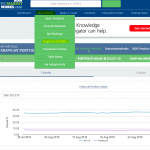The golden rule of stock investing dictates cutting your losses when they fall 10 percent from the price paid, but common wisdom just might be wrong. Instead, use some common sense to determine if it’s time to hold or fold.
- Diversification. If your total portfolio is down 10 percent, but diversified then the diversification itself is one layer of protection. Don’t automatically assume you need to sell all of your stocks and start over.
- Dividends. If the stock pays dividends, then calculate the total dividend plus stock price in your estimates before making the decision to sell.
- Dumb Pricing. If you paid too much to begin with, then a 10 percent correction will often work it’s way out if you hold a bit longer. Just stop buying high and learn your lesson in the future. Then again, extra caution is advised because if you bought wrong to begin, then there is little chance you have the required savvy to know when it’s time to fold.
The final rule of investing is to make informed decisions so instead of blindly following the 10 percent rule, use the following recovery estimates and averages. Remember, a 25 percent return on investment is a strong return, 100 percent is very rare. Beyond that is a long tail that cannot be relied upon or properly forecasted. With that in mind …
| If stock drops | Then the stock must gain to break even |
| 5% | 5.26% |
| 10% | 11.1% |
| 20% | 25.0% |
| 30% | 42.86% |
| 40% | 66.67% |
| 50% | 100% |
As this table shows, cutting your losses quickly in a losing stock and reinvesting in another stock is often the smart play.
 Using Spreadsheets – Calculating Your Daily Returns
Using Spreadsheets – Calculating Your Daily Returns Online Payroll Can Reduce Human Error in the Payroll Process
Online Payroll Can Reduce Human Error in the Payroll Process
